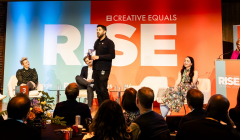
Are we leaving men and boys behind?
At Creative Equal’s RISE event, industry leaders consider how to reframe boys and men in marketing

As the Premier League re-starts in earnest this month and sporting bodies gently ease restrictions on training, now is the perfect time to reappraise the power of sport in marketing.

“Most people don’t care when football is coming back, or whether it’s ever coming back.” Even amidst the sea of empty declarations devoid of empirical evidence that have been proclaimed by columnists since the Coronavirus crisis began, this statement by Times commentator Matthew Parris is deeply out of touch with the role of sport in consumers' lives across the UK and beyond.
As the Premier League prepares to return to screens on the 17th June, the cultural void that the lack of live sports has created in lockdown is in sharp focus. As a recent research paper from Dark Horses on the “once in a century opportunity” the return marks for brands declares: “True fans will know that it is precisely the needlessness of sport that makes it so fundamental to our lives. It is because it is done purely for pleasure and entertainment that makes it so worthwhile at a time when we have been restricted to our homes and kept apart from our loved ones.”
The cultural and emotional void left by the pause placed on live sports has been keenly felt by consumers, brands and agencies alike. From sports commentators providing voice overs in their signature style for the mundane moments of life, to the plethora of brands pivoting to support exercise at home and online gaming; now is truly an unprecedented time for rights holders, sports brands and sponsors alike.
At the same time, as Parris’ comments underline, sport is all too easily dismissed as unimportant in the midst of the crisis. Yet arguably, as consumers navigate the uncertainties, anxieties and grief of this crisis, sporting communities are more vital than ever. A marketing opportunity which is far bigger and more meaningful than the Premier League alone. Across the country grassroots sports organisations and clubs, so vital to the communities they serve, are on the brink of economic collapse.
As society continues to grapple with the mental impact of lockdown on young people, the vital role of local sports clubs should not be overlooked. Funding and support from brands, individuals, government and governing bodies will be vital to their long-term survival, as well as the long-term health of the nation. The sports sponsorship industry has never been more culturally vital.
So, how can brands ensure they are not on the side-lines at this brand-defining time, but instead capitalise on the power of supporting sporting communities, or invest in building their own?
What has become clear as social distancing continues is how much sport not only facilitates physical exercise, but community and competition.
Rory Natkiel
![RoryHeadShot[2].png](/application/files/cache/118796607e320ef05a1e6c4ed0b68c54.png)
COVID-19 has revealed just how significant a role sport plays in our lives. While we saw an instant uptake in physical exercise immediately after lockdown, arguably one of the best examples of limiting supply to increase demand that I’ve ever witnessed, what has become clear as social distancing continues is how much sport not only facilitates physical exercise, but community and competition.
The industry was quick to respond to the lockdown in a number of ways: Joe Wicks became arguably the first lockdown celebrity in the UK, and we saw pivots from brands such as Under Armour and New Balance switching production to produce PPE equipment in the US.
But with social distancing likely to continue as part of the ‘new normal’, I think there’s an onus on the sports industry to find new ways to facilitate the unique connection that mass exercise provides, and look for ways to provide communal and competitive experiences for communities that previously thrived on them.
The explosion in livestreamed exercise classes isn’t just because people want to stay fit, it’s that they also allow us to gather together in sport even though we are apart. Brands that are inherently virtual are well placed to facilitate this. Peloton has seen some classes with over 20,000 people taking part. Zwift are a great example of a brand that is responding to this by creating a new virtual race series featuring pro teams that will be broadcast live on Eurosport.
As we look to the return of winter sports such as the football, rugby, and the NFL in the US, clubs and broadcasters will need to develop innovative solutions to respond to the potential reality of games being played behind closed doors. So, we can foresee the rapid digital transformation that C-19 has prompted across all sectors also impacting sport.
However, the sport industry is able to play a wider role in providing hope and meaning to consumers in the face of tragedy. It can provide a reason to stay optimistic and to keep moving. Our recent work for adidas tried to focus on this, by looking forward to the time when we will play again. In doing so it proved hugely motivating not only for customers but also for adidas employees around the world.
It’s simple: sporting communities are one of the most engaged audiences of any sector.
Caroline Paris

The strongest brands create an emotional connection with their consumers. A relationship born of the heart, not the head.
By their very nature, sports teams and the stars within them, have an incredible strength of bond with their associated communities. We often use the insight, ‘You can change your house, car, move to a different country and find a new life partner, but you might never change the team you support.’
That’s because sport has a unique emotional power. In no other walk of life do our hearts and minds become so inextricably linked to the activities of people we do not personally know, but who we admire with a passion. It’s simple: sporting communities are one of the most engaged audiences of any sector.
Because of this, numerous brands put sport at the heart of their marketing strategy to drive growth and engagement with consumers. Global spending on sports sponsorship alone was predicted to grow to £48bn by 2024 pre the current global pandemic.
Whilst COVID-19 has caused enormous hardship, personal strife and anxiety, the sports-shaped hole left in the world, and what it represents, has been felt strongly by many. A recent IMI research showed that 21% of UK consumers are missing being able to watch live sports events, and 21% miss watching sport with family and friends.
Now, as the impact of the virus continues to be felt, the role of sport brands is set to become the ‘enabler’ and give people access to the things they are missing the most: togetherness, authenticity and passion. If brands can legitimately play in this space and echo those feelings, then now is certainly the time to do so.
These brands have a new or in some cases, renewed purpose: ensuring that their messaging is authentic by creating campaigns that align with their fundamental brand values. If 2020 has brought anything positive, it is the opportunity for these brands to bring fans closer to the game they love and fill part of the void we are experiencing as a nation. A powerful and unique canvas on which to play and entertain.
While other crises reshaped the future, COVID-19 is just making the future happen faster.
Charles Jefferson

The key to the question is in that word: community.
Sport is built on community, whether that be a global fanbase or a local grassroots team, it’s all about togetherness; a mutual coming together.
Brands need to remember what it is that binds these communities but do so without forgetting their own role and purpose. What this means is, there is actually a huge opportunity to evolve from brand activation into meaningful brand action.
Brand action is based on the needs and desires of a community in lockdown:
· Togetherness – a sense of belonging
· Reassurance – creating belief and hope
· Assistance – we’re in this with you
· Distraction – make us smile, laugh or cheer
The starting point should then be very simply, “How can we best help?”. What is the most appropriate role for us, which also means don’t jump onto the home fitness bandwagon if you’re a betting company.
If you’re a sponsor, you should show empathy with rights holders and look at ways to work with them to add value; to integrate services and technologies rather than immediately asking for clawbacks and make goods. Think of ways in which you can tangibly help fans connect to their passions.
Be true to your brand and don’t force yourself into conversations that don’t fit your core partnership principles. Don’t be afraid to explore opportunities to do things differently. These are unprecedented times, constantly evolving and brands need to be nimble, flexible and innovative.
Maximise current talent availability to create more meaningful, purpose driven and engaging fan experiences. We know relevance rules and that talent dominate the conversation. We just need to rethink how we use them. Less physical, more virtual. Reduce ‘overproduction’ which can lead to staged and awkward moments. Talent will thank you as they will be more amenable to this less disruptive approach to their lifestyle.
As the traditional sports calendar has been decimated, the hiatus has enabled brands to explore new event formats, likely to be virtual, gaming/esports-led or remote home-based events enabled by technology.
Things won’t change as much as they will accelerate. While other crises reshaped the future, COVID-19 is just making the future happen faster. It’s time for brands to act with purpose, be bold and lead their communities in these dynamic times.
If brands want to ‘capitalise’ on the power of sporting communities, then do it in the right way: invest in partnerships.
Joel Seymour-Hyde

The green shoots of sport returning are now starting to emerge in the UK. Golf courses and tennis clubs reported an immediate surge in bookings on Wednesday, following the slight easing of lockdown conditions, and there are ongoing discussions and debates about the feasibility of the return of professional sports.
The role for brands at this time is complex, and also somewhat predicated on the role they played prior to the start of the COVID crisis.
For those brands that had already demonstrated their commitment to sporting communities via existing partnerships/sponsorships, there have been significant efforts to reach audiences via digital channels, hastily revised content plans and smart ideas utilising video communications, plus of course many wonderful examples of fundraising and support for local communities using sport as a platform.
These brands are now working hard to develop ideas for the next stage of the COVID-19 crisis, which is the likely return of professional sports in a behind closed doors format. The brief is reasonably straightforward: how to add value to the ‘behind closed doors’ fan viewing experience.
To answer it presents an exciting creative and executional challenge for brands, with numerous activation opportunities, from creating more immersive and ‘exclusive’ communal viewing experiences; to additional behind the scenes content; through to utilisation of second screen technology; or heaven forbid, could this finally be the moment that the much vaunted but not yet realised ‘live VR’ experience has lift off?
For those brands who have not previously invested in sport significantly, but have observed with interest in this period the missing role in consumers lives’ that sport does play, whether that be health and wellbeing, entertainment or a sense of community and identity, my suggestion, rather than recommendation would be simple. Don’t use this simply as a chance to jump on the bandwagon through upping media spend or producing content around the sporting ecosystem: become a part of it.
One of the inevitable consequences of the COVID-19 crisis will be that many sports organisations, governing bodies and athletes will be facing some significant and, in some cases, terminal financial difficulty.
If brands want to ‘capitalise’ on the power of sporting communities, then do it in the right way: invest in partnerships, at all tiers of sport, from local community initiatives to elite professional sport, to ensure investment goes to the right places, and the brand can create content and experiences that are genuinely authentic, relevant, and really supporting these communities. There are many, many opportunities across the entire sports ecosystem in the UK right now, to fit all types of brands and budgets.
Most importantly, this will help ensure that the benefits sport brings can continue to be felt by all who wish to access them in the future.
Sport occupies a uniquely powerful place in culture, which transcends the game itself.
James Morris

If ever there was a time when actions mattered, it's now. Sport occupies a uniquely powerful place in culture, which transcends the game itself. As marketers, we have an individual and collective responsibility to enable that power to do more.
For me, the question isn't how brands can capitalise on the power of sporting communities, but how brands can support them, with purpose, creativity and innovation to make a meaningful difference to fans, teams and society as a whole. Brands like Nike have understood this, and those that get it right, will be rewarded.
Lockdown has accelerated how we use technology to communicate, socialise, work and purchase. We now have an opportunity to reinvent how brands and sport work together, transforming their interaction with fans. So, as matches and races restart behind closed doors, where do we begin? I think it should start with ‘access’.
First, we need to address the impending issue of the flat experience of playing in empty stadia and watching games in isolation. Exacerbated by a highly condensed sporting calendar spread over multiple platforms, we will need exceptional, tech-enabled and data-driven ideas to earn attention.
We also need to think long-term. Reliant on monetising attendance, lower league clubs, teams and their communities need brand support more than ever to survive. How could technology work across the league to engage fans, boost revenue and support sport at the grass roots, so crucial for encouraging more diverse talent into the game and for the health and wellbeing of sports overall? And where brands are involved and invest at the highest levels of sport, how can that influence be used to encourage greater diversity not just on the playing field, but in the boardroom, among management and the coaching staff?
As a new reality dawns, agencies must have the ambition to go beyond the next campaign and create something that can live forever. With a shared vision, collaborating across lines with clients, talent, teams, rights owners and technology companies, we should unlock the power of sport for all, providing a new and improved experience and access for fans, communities and a legacy we can all be proud of.
Looks like you need to create a Creativebrief account to perform this action.
Create account Sign inLooks like you need to create a Creativebrief account to perform this action.
Create account Sign in